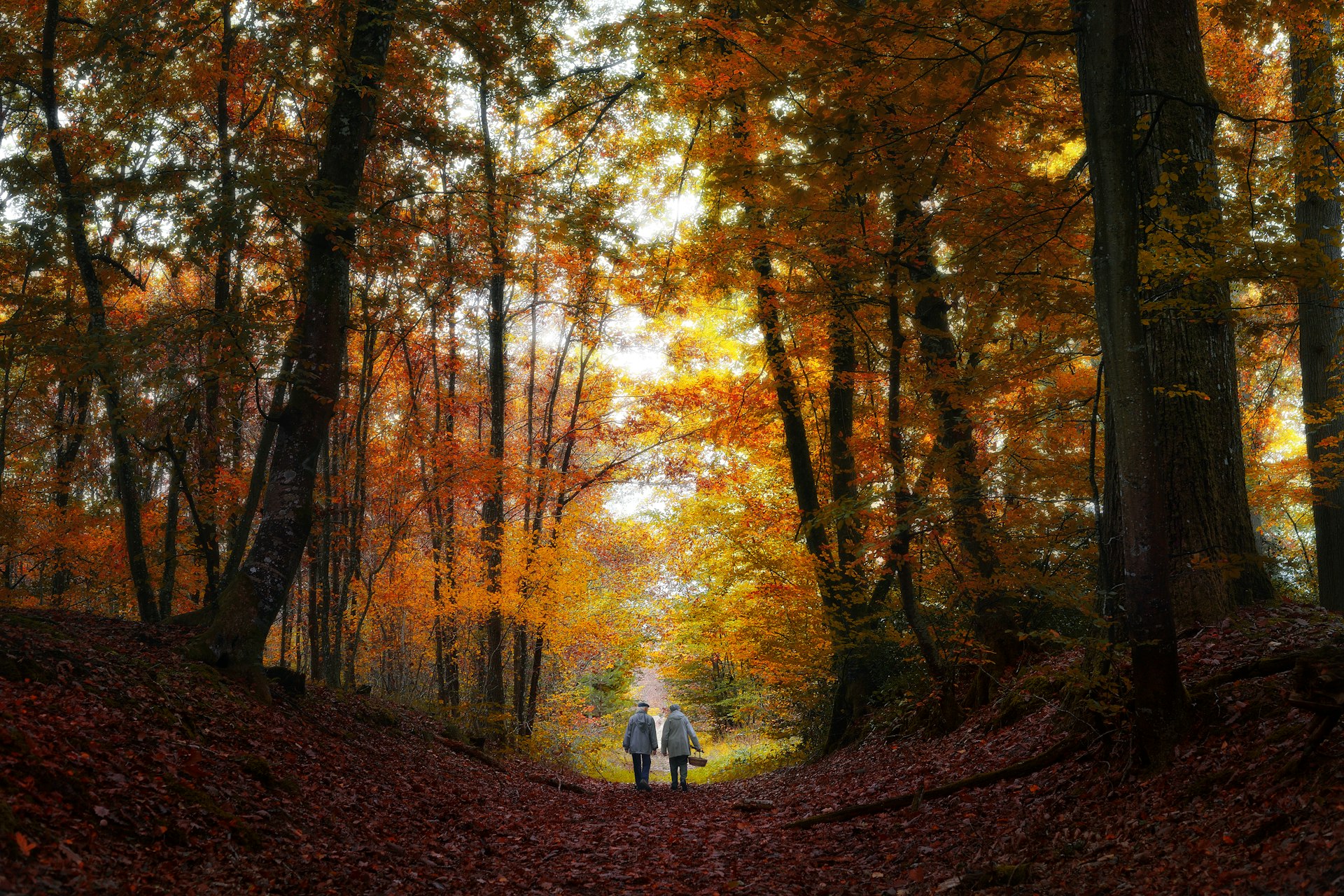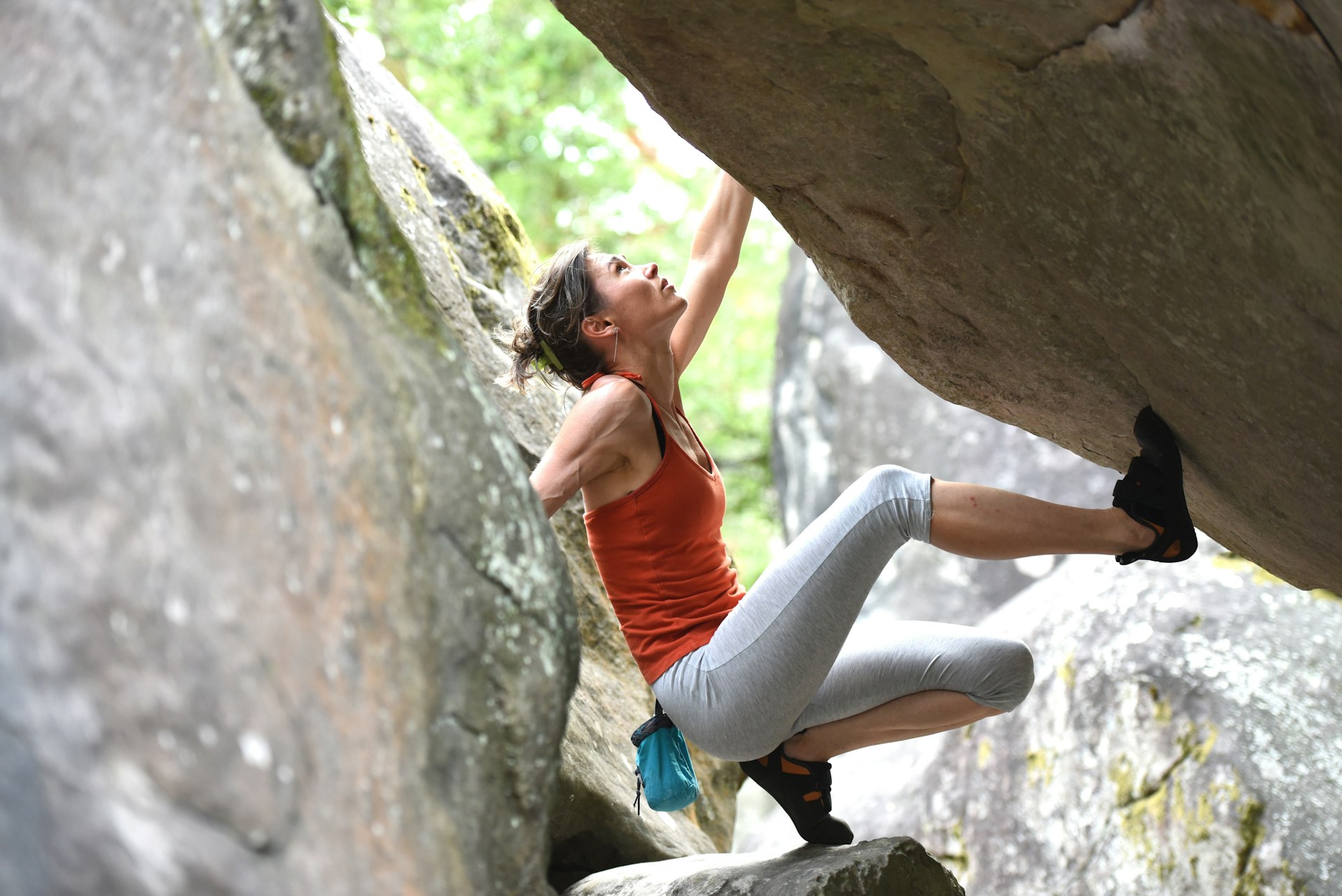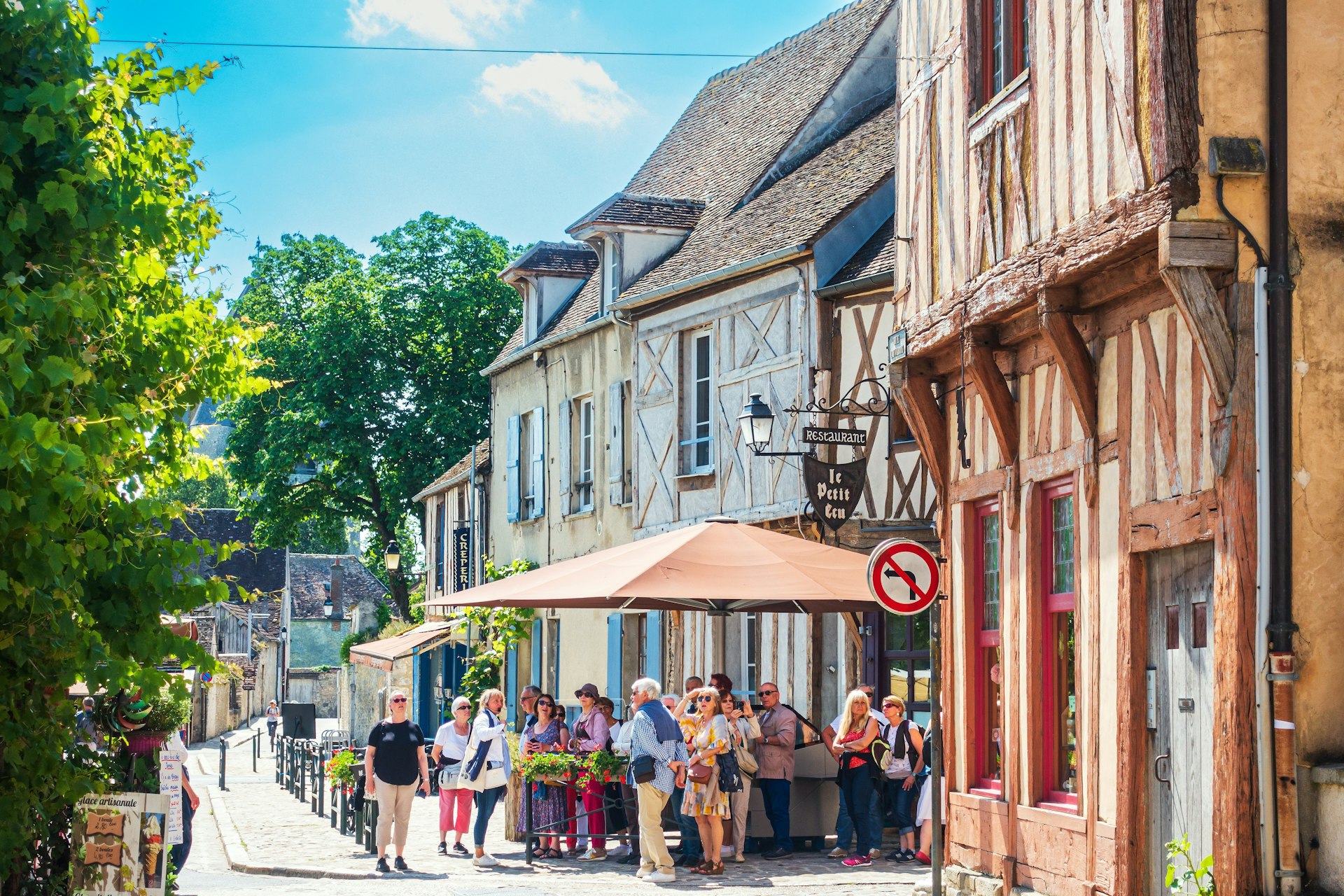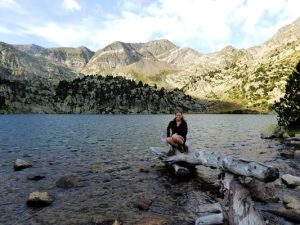
History and art enthusiasts will have plenty to admire in Fontainebleau, not only at the palace, which for eight centuries was called home by the 34 French kings and two emperors who embellished and enriched it, but also at Vaux-le-Vicomte, which predates and inspired Versailles.
And when your mind is full and you want to stretch your legs and challenge your muscles, you can of course rock climb, as Fontainebleau forest is world-famous for its bouldering opportunities, but also cycle, walk, ride, canoe and swim, to name but a few.
Explore the planet’s most surprising adventures with our weekly newsletter delivered to your inbox.
When should I go to Fontainebleau?
Any time at all to visit the châteaux and villages or to cycle and walk, and whenever it’s dry if you want to climb rocks. If you want to canoe or wild-water swim, then from about mid-May to mid-September.
Is it easy to get to and around Fontainebleau?
It’s a 35-minute, €5 train ride from Paris Gare de Lyon to Fontainebleau-Avon. A 2.9km stroll through the château’s park along the canal (or through town) and you’ll reach the palace. Or you can take bus 1, which leaves every 15 minutes from the train station. Get off at the Bibliothèque stop for the château.
If you’d prefer a taxi, book one ahead, as you’re unlikely to find one at the station.
You can reach many of the small towns and villages by public transport, but to be honest, service is infrequent (one bus every few hours, for example) and can be complicated, so it’s easiest to either drive or cycle. The EuroVelo3 cycle route (called the Scandibérique for its French segment) serpents along the Seine and the Loing through almost all the towns and villages highlighted here, and you can join it at the train station.
Blow Cycles inside the train station and Velectrik Moov in the city center rent electric bikes (€39 for a half day, €59 full day), perfect for cycling along the sandy paths through the forest.
If you’re looking for a traditional pedal road bike, then rent one (€8 per hour, €15 per day, €55 per week) from La Petite Reine in the city center. For all three it’s wise to book ahead.
Why you should visit
There is a lot more to the region, just 55km (34 miles) southeast of Paris, than châteaus, forest and rocks, so it’s worth spending at least two days here. If you don’t want to be rushed, particularly in summer, you could easily pass a pleasant four days, especially if you want to spend an afternoon cooling off in the river Loing. (There are no lifeguards so it’s officially forbidden, but everybody does it anyway!)
What are the best things to see and do in Fontainebleau?
 Château de Vaux-le-Vicomte offers candlelight visits and a host of other activities © Sizun Eye / Getty Images
Château de Vaux-le-Vicomte offers candlelight visits and a host of other activities © Sizun Eye / Getty Images
Visit the Château de Vaux-le-Vicomte by candlelight
The story goes that when Louis XIV’s finance minister, Nicolas Fouquet, invited the king to his château-warming party in 1661, the luxury and beauty enraged the young king, who promptly clapped Fouquet behind bars for life and engaged the architect, artist and gardener to create something even grander: Versailles.
The current owners of the château are the fifth generation of their family to manage the domain, which opened to the public in 1968. Check the Vaux-le-Vicomte website for information on the 2023 program of candlelight visits, fireworks, dressing-up days and a host of other activities.
Planning tip: There is a dedicated shuttle bus, the Châteaubus, that runs the 9.4km from the Café de la Gare at Melun train station to the estate. Book online and check the schedule here.
Visit Fontainebleau Palace
Francis I, a keen hunter, wanted somewhere comfortable to stay in the deer- and boar-filled forest, so in 1528 he ordered the fortress built by Louis VII in 1137 to be rebuilt and decorated in what would become known as the School of Fontainebleau style: a combination of frescoes surrounded by a riot of willowy, stucco figures.
It became Henry IV’s favorite home, the birthplace of Francis II, Henry III and Louis XIII, a roof over Louis XIV’s head while he waited for Versailles to be built, the place where Louis XV and Marie Leszczynska were married, a refuge from the formality of Versailles for Louis XVI and Marie-Antoinette and a golden prison for Pope Pius VII from 1812 to 1814. Today it is a Unesco World Heritage Site.
You can visit 121 of the palace’s 1536 rooms – some on your own, others only with a tour-guide – and admire more furniture than in any other castle in Europe!
Fontainebleau did not suffer the same fate as Versailles in the wake of the 1789 French Revolution. The latter was never lived in again whilst the former became an imperial palace, restored by Napoleon Bonaparte (1769–1821). You’ll see the only Napoleonic throne room in the world here.
As you walk down the beautiful Horseshoe staircase (renovated in 2022) at the front of the palace, imagine how the Emperor must have felt that day in April 1814, when he stood there and said goodbye to his troops gathered in the vast courtyard before leaving for exile in Elba. This courtyard has since been known as the Cour des Adieux (Farewell Courtyard).
The beautiful but fragile Imperial Theatre was built in the southern wing in the 1850s on orders of Emperor Napoleon III. It was only used for about a dozen performances before the main access was walled up in the 1870s and then “rediscovered” in the early 21st century, together with one of the best-preserved collections of 19th-century stage sets in France. After extensive restoration work, which maintained 80% of the original furniture and décor, the theater opened in 2014 for guided tours only.
Built between 1606 and 1608, the 1.2km-long (.75-mile) ornamental canal predates those of Vaux-le-Vicomte, Versailles and Chantilly. Parts of the walk around the canal are inaccessible until autumn 2023, when the major repairs currently underway should be finished.
If the small white door to the left of the clock tower on the main facade is open, go inside to see the Jeu de paume (real tennis court), the only historic one in France still in use. If you’d like to have a go, contact the coach.
Planning tip: Open daily (except Tuesdays) from 9:30am to 6pm; last entry is at 5:15pm, or an hour earlier from October 1 to March 31. The general-admission ticket is €14 and will allow you to visit the Grands Appartements and the Napoleon 1 museum. Access to the park and gardens is free. You can visit other parts of the palace with a tour guide, and there is a wide range of activities (in French only) for children.
 The forest of Fontainebleau has many straight paths, so it’s easy to find your way around © www.fredconcha.com @ All Rights Reserved / Getty Images
The forest of Fontainebleau has many straight paths, so it’s easy to find your way around © www.fredconcha.com @ All Rights Reserved / Getty Images
Hike or cycle along myriad paths in the Forest of Fontainebleau
If you’d come to this 220-sq-km (84-sq-mile) forest 30 million years ago, you’d have been swimming in a warm ocean. This left its mark in the shape of a layer of very fine-quality sand, covered by a layer of sandstone. Over the eons of time, water, flora and fauna fashioned the chaos of sandstone boulders, heather and fern under a canopy of oak, beech, scots and maritime pine trees.
As you cycle or walk along the many straight paths (which are named so it’s easy to find your way around), you’ll notice how incredibly fine and soft the sand is. It’s considered one of the highest-quality sands in the world and is used mostly to make glass, notably for the Louvre Museum pyramid.
Planning tip: If you’re driving in the area at night, be extremely careful, as accidents with boars, stags and deer are frequent.
To see glass objects being created, visit the Verrerie d’art (artistic glass) workshop at Soisy-sur-Ecole, 20km north-west of Fontainebleau.
Explore the town of Fontainebleau and its market
Like an island, surrounded by the forest that curtails its expansion, Fontainebleau is a town without suburbs or ugly business parks.
It’s a thriving, upscale town of 16,000 inhabitants (of whom 18% are foreigners, due to the presence of top-ranking international educational establishments), filled with boutiques, bars and restaurants ranging from Michelin-starred to street food, catering to everyone from elegantly dressed grandparents to families with babes in strollers to cash-strapped youngsters camping here to rock climb.
The 100-plus-stall market, held on Tuesday, Saturday and Sunday mornings, is particularly lively on weekends, when bellifontains (inhabitants of Fontainebleau) carefully select ingredients for long family lunches and students rummage for a good deal at the clothes’ stalls.
Stop by the cheesemonger’s stand (more expensive than the supermarket but incomparably better) and choose one of the local Brie cheeses (thus named because this is La Brie region): Brie de Melun, de Meaux, de Montereau, de Nangis or de Provins. All slightly different; the historical one is from Provins. Coulommiers, Fougerus, Orvannais and Gratte-Paille are also local cheeses.
A baguette from the baker, fruit from the market gardener, a calorie-filled Fontainebleau desert (quark topped with Chantilly cream), a bottle of something and you’re all set to explore!
 Fontainebleau is hugely popular with climbers all over the world © photofort 77 / Shutterstock
Fontainebleau is hugely popular with climbers all over the world © photofort 77 / Shutterstock
Climb some rocks
Hugely popular with climbers all over the world, Fontainebleau gave its name to the “Font” bouldering grading scale, and there are thousands of problems for climbers of every level here, from expert to novice. (Not being a climber myself, I used to wonder why so many people at the train station in Fontainebleau were carrying mattresses!)
Planning tip: The major climbing areas are accessible from car parks, but keep in mind that those north of Fontainebleau (closest to Paris) can get pretty crowded at weekends. For detailed information about the different bouldering areas, see this dedicated website.
 Fontainebleau is the horse capital of France © photofort 77 / Shutterstock
Fontainebleau is the horse capital of France © photofort 77 / Shutterstock
Admire the horses
Fontainebleau is the French horse capital (except racing – that’s in Chantilly, even if there are races at Fontainebleau’s lovely Hippodrome de la Solle). Events are at the Grand Parquet, one of the largest equestrian stadiums in Europe. You can cycle there from the train station.
The Military Riding Academy, open for guided tours one Saturday a month from April to July, is in the palace grounds. An officer will guide you around the facilities, whose function hasn’t changed since they were built 500 years ago. You’ll see the farrier’s and saddler’s workshops, 300 horses and a superb view of the palace across the Étang des Carpes (carp pond).
Planning tip: To visit the Military Riding Academy you must reserve. Guided tours are in French, but if you book as a group the visit can be in English. Check the agenda for upcoming competitions at the Grand Parquet, which, by the way, will serve as the rear base for the Paris 2024 Olympic equestrian events.
 There are myriad things to do on or along the region’s three rivers, including kayaking on the Loing © Elena Dijour / Shutterstock
There are myriad things to do on or along the region’s three rivers, including kayaking on the Loing © Elena Dijour / Shutterstock
Enjoy the rivers
Three major rivers, the Seine, the Yonne and the Loing, flow through the region. Did you know that the river meandering through Paris should be called the Yonne? That’s because at the confluence of the Seine and the Yonneat Montereau-Fault-Yonne, just south of Fontainebleau, the Yonne’s 93-cu-meter-per-second flow is greater than the 80-cu-meter flow of the Seine, so if hydrographic rules were strictly applied, it is the Seine that is a tributary of the Yonne and not the other way around!
The confluence of the Loing and the Seine is at St Mammès, more of which later.
There are myriad activities to do on or along these rivers. For some, such as rowing or sailing, you need to be a member of the club in question. But as a visitor you can rent a kayak on the Loing for either a half-day or full day from Nature Loisir Evasion (prices range from €42 to €62) at La Genevraye; from Top Loisirs (from €37 to €62), 82 route de la Houzelle, Moret-sur-Loing; or from Apikopa (online reservations only from €42 to €62).
You can also water ski on the Seine at the Club Nautique de Chartrettes from €40 for adults (€30 for those under 18 and €15 for those under 10, equipment provided). It’s about a 10km (6.2-mile) bike ride from the train station at Fontainebleau.
Planning tip: If you follow the Seine either upstream or downstream from Fontainebleau, you will see some huge, bizarre houses. Known as Affolantes, these extraordinary country retreats were built between 1830 and 1914 for wealthy Parisians by architects whose imaginations ran wild: medieval tower, Swiss chalet, fake timber, all rolled into one. The 50 or so houses are privately owned and closed to the public.
Bring your easel, like the artists who flocked here
The combination of forest, rivers and picturesque towns so close to Paris attracted many 19th- and early 20th-century artists eager to paint outdoors.
Jean-Baptiste Camille Corot, Théodore Rousseau, Jean-François Millet, Rosa Bonheur and Alfred Sisley were amongst those who settled in the region, together with a number of foreign artists and authors, including Robert Louis Stevenson, Kuroda Seiki, Carl Larsson, John Singer Sargent and Emma Chadwick.
 Most of the small towns and villages in the region are really pretty, and Provins is no exception © ilolab / Shutterstock
Most of the small towns and villages in the region are really pretty, and Provins is no exception © ilolab / Shutterstock
My favorite thing to do is explore the small towns and villages
The reason artists flocked here is because most of the small towns and villages in the region are really pretty, with warm greige exposed-stone-and-limewash houses lining narrow streets that cluster around a medieval church and village square, with its pollarded trees and a river usually close by.
Most of the small roads through Fontainebleau forest have been closed to traffic for more than 20 years, so it is safe and pleasant to cycle or walk to one of the villages, where you can just let your instinct guide your steps up and down the streets. I like to compare today’s view with the panels that have been set up in some villages on the exact spot where an artist set up their easel 100 years or more ago, and then enjoy a simple meal in one of the many restaurants.
How much money do I need?
Bouldering, walking, wild-water swimming, visiting the villages and the churches are all free. Entry fees for the museums depends on your age and whether or not you come from an EU member state, but count on about €4 for the village museums to €17 for the châteaux or Rosa Bonheur museums. Fontainebleau Palace is free on the first Sunday of every month except July and August.
You’ll find accommodations and places to eat to meet every budget. At the luxury end there are hotels, such as the very central Aigle Noir or the family-run Hôtel de Londres, that could set you back from €580 to €800 for two nights for two in the deluxe rooms.
At the budget end there is the municipal campsite along the river Seine in Samoreau, a 3.4km (2.1-mile) walk from the Fontainebleau-Avon train station, where you can pitch your tent for two days for €27.20. In between the two extremes there are also guest-houses and middle-ranking hotels.
Similarly for food. You could opt (if you’ve booked ahead) for L’Axel, the Michelin-starred restaurant run by Japanese chef Kunihisa Goto that offers tasting menus with wines from €155 to €270. Or you could buy a freshly made sandwich from one of the many boulangeries (bakeries) in town for about €6. There are a host of restaurants to suit every taste and every budget. Remember, this is a student town!



